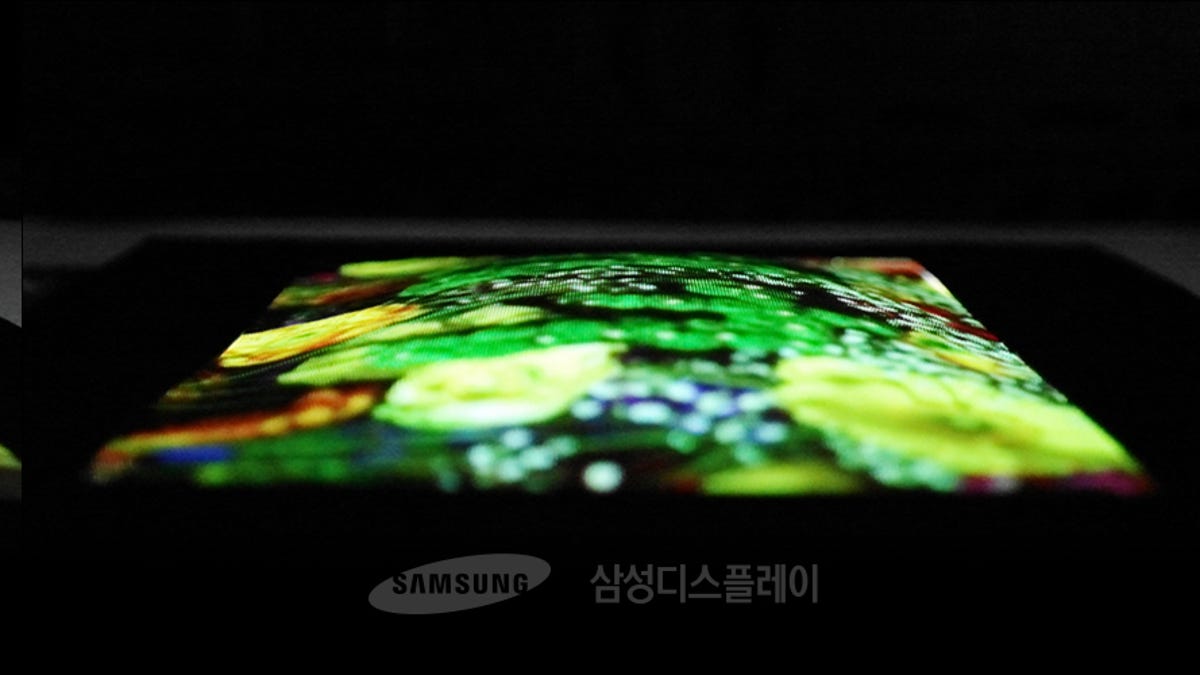Forget flat and curved, Samsung's new display stretches
The company has developed new OLED screen technology it says could eventually be used in wearables, cars and other devices.

Here we thought the next cool screen tech would be foldable displays. Turns out, they could be stretchable.
Samsung this week showed off new display technology that looks kind of like a trampoline. The 9.1-inch stretchable OLED display prototype, which Samsung called the first of its kind, can be flexed in two directions, unlike conventional flexible OLED displays that can be formed in only one direction (such as bending, folding or rolling).
When you press the screen from above, it depresses like a rubber balloon, Samsung said, then bounces back to its original flat shape. "The screen when stretched up or down, even when pressed, has sufficient elasticity to recover," Samsung said.
The company's technology lets the display maintain its original image quality while increasing the screen depth up to 12mm when the display is pressed.
The technology is only a prototype right now, and Samsung couldn't say when it could show up in real products. But the company predicted that it may one day be used for wearables, internet of things devices, and automotive and artificial intelligence applications.
For instance, the display could be weaved on an information screen tag in a hospital patient's garment to instantly give updates on the patient's medical status. The texture could be similar to fabric so it would be comfortable, Samsung said. Or in self-driving cars, the display could be stretched across the front dashboard, curving with the natural shape of the interior instead of requiring a flat, large display. And for robots, the stretchable display could be used as a face or three-dimensional button that can instantly change from flat to convex shape.
"It is considered to be a very promising future technology," the company said.
Samsung's stretchable display can be flexed in two directions, unlike conventional flexible displays, which can be formed in only one direction (such as bending, folding or rolling).
Along with being the world's biggest phone and TV maker, Samsung also has huge operations making displays and other components. It uses those displays in its own products and also sells them to other device makers. As people get bored with smartphones and other devices, companies like Samsung are looking for ways to make the gadgets innovative and exciting again. That includes incorporating advanced screen technologies.
When it comes to futuristic displays, Samsung is one of the market leaders. Its flexible displays are used in its Galaxy S8 and S8 Plus phones. Those devices don't actually bend, but the flexible characteristics are what allow the screen to curve around the sides of the phone. Samsung has also shown off foldable and bendable displays, which its head of mobile, D.J. Koh, has said he's "very, very much interested in."
LG also has worked on advanced screen technology. It showed off a "wallpaper" TV in January at CES in Las Vegas. The superskinny OLED TV hangs on a wall and protrudes no further than a couple of coins stacked together. Unlike the new Samsung stretchable display, LG's TV, called the W7 OLED, is an actual product you can buy, for about $8,000.
Samsung showed off the new stretchable screen technology this week at the Display Week trade show in LA.
Update at 3:05 p.m. PT to include more details about future uses for the displays.
Does the Mac still matter? Apple execs tell why the MacBook Pro was over four years in the making, and why we should care.
Virtual reality 101: CNET tells you everything you need to know about VR .

